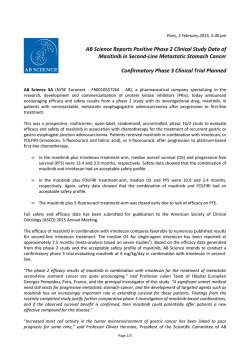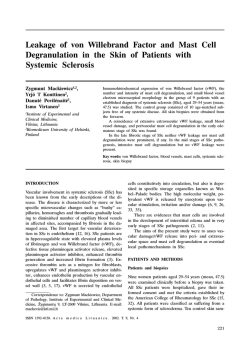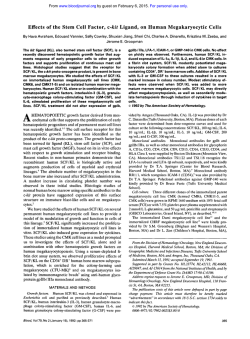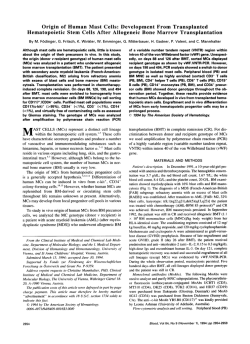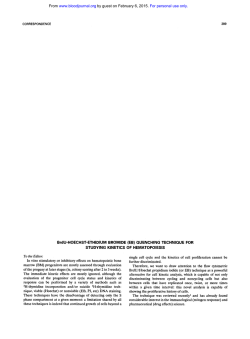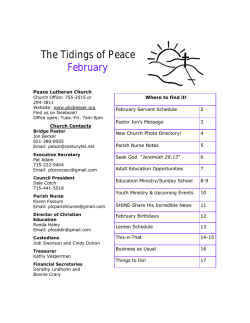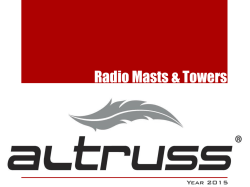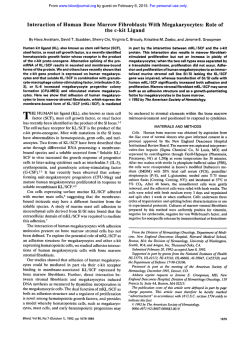
Long-Term Generation of Human Mast Cells in Serum-Free
From www.bloodjournal.org by guest on February 6, 2015. For personal use only. Long-Term Generation of Human Mast Cells in Serum-Free Cultures of CD34+ Cord Blood Cells Stimulated With Stem Cell Factor and Interleukin-3 By Brigitte Durand, Giovanni Migliaccio, Nelson S.Yee, Keith Eddleman, Tellervo Huima-Byron, Anna Rita Migliaccio, and John W. Adamson The generation of murine mast cells is supported by several cytokines, and mast cell lines are frequently established in long-term cultures of normal murine marrow cells. In contrast, growth of human mast cells was initially dependent on coculture with murine fibroblasts. The growth factor produced by murine fibroblasts and required t o observe differentiation of human mast cells is attributable in part t o stem cell factor (SCF). However, other factors are likely involved. We havepreviously shown that the combination of SCF and interleukin-3 (IL-3) efficiently sustains proliferation and differentiation of colony-forming cells (CFCs) from pre-CFC enriched from human umbilical cord blood by CD34+selection. With periodic medium changes and the addition of fresh growth factors, five consecutive cultures of different cord blood samples gave rise to differentiated cells andCFCs for more than 2 months.Although differentiated cells continued t o be generated for more than 5 months, CFCs were no longer detectable by day 50 of culture. The cells have the morphology of immature mast cells, are Toluidine blue positive, are karyotypically normal, are CD33'. CD34-, CD45+, ckit-, and c-fms-, and diein the absence of either SCF or IL3. These cells donot form colonies in semisolid culture and are propagated in liquid culture stimulated with SCF and IL3 at a seeding concentration of no less than IO' cellslmL. At refeedings, the cultures contain a high number (>50%) of dead cells and have a doubling time ranging from 5 t o 12 days. This suggests that subsets of the cell population die because ofa requirement for a growth factor other than SCF or IL-3. These results indicate that the combination of cord blood progenitor and stem cells, plus a cocktail of growth factors including SCF and IL-3, is capable with high efficiency of giving rise in serum-deprived culture to human mast cells that behave like factor-dependent cell lines. These cells may represent auseful tool for studies of human mastcell differentiation and leukemia. 0 1994 by The American Societyof Hematology. P We have previously shown that the combination of SCF and 1L-322,23is at least as efficient as a stromal l a ~ e ? !in~ sustaining the proliferation and differentiation of colonyforming cells (CFCs) from pre-CFC in serum-deprived liquid culture. The target cells for our studies were CD34+ cells isolated from human umbilical cord blood. In this report, we describe the establishment of long-term cultures of human mast cells from normal human CD34+ cord blood cells in stroma-free suspension culture stimulated with SCF and IL3 under serum-deprived conditions. ROLIFERATION OF murine mast cells is sustained by several cytokines including interleukin-3 (IL-3), IL-4, IL-9, and IL-101-4,as well as stem cell factor (SCF):-' which is also termed mast cell growth factor' or kit ligand.' Furthermore, in long-term cultures of normal murine marrow cells, cell lines have frequently been established based on their dependence on IL-3 for g r o ~ t h . ' ~ . ' 'Although "~ they retain the capacity to differentiate along other hematopoietic lineages when stimulated with appropriate growth factor^,'^,^^,'' most of these cell lines have a mast cell phenotype." The cells are karyotypically normal by light microscopy and they do not induce tumors when injected into syngeneic recipients. The molecular events that result in immortalization of these cell lines are unknown. In contrast, several human cytokines, including IL-3, have failed to sustain proliferation of human mast cells and, to date, no cell lines have been established from normal human long-term marrow cultures. However, human stromal cells supporting long-term hematopoiesis are less efficient than their murine counterparts.'6 In vitro, growth and differentiation of human mast cells have been reported in cocultures of mononuclear cord blood cells and Swiss albino/3T3 fibroblasts." The growth factor produced by the murine fibroblasts and responsible, at least in part, for proliferation and differentiation of the human mast cells, recently has been identified as SCF," the ligand for the receptor encoded by the proto-oncogene kit.^,^,'^ In fact, several independent reports have shown human mast cell differentiation from unfractionated cord blood mononuclear cellsI8or adult blood and marrow2" in serum-supplemented cultures stimulated with SCF. Cells with a mast cell phenotype were first detected after 4 weeks of culture''.2o and became the predominant cell population by week 13. The cultures were not maintained beyond that point. However, the establishment of rat mast cell lines has been reported in cultures stimulated with SCF." Blood, Vol 84, No 11 (December l ) , 1994:pp 3667-3674 MATERIALSANDMETHODS Collection and separation of cord blood cells. Umbilical cord blood samples were collected at the New York Hospital-Cornell From the Laboratory of Hematopoietic Growth Factors, The New York Blood Center, New York, NY: Dipartimento di Biologia Cellulare, Istituto Superiore di Sanitci, Rome, Italy; Molecular Biology Program, Sloan-Kettering Institute: Cornell University Graduate School of Medical Sciences: andthe Division of Maternal Fetal Medicine, TheNewYork Hospital-Cornel1 Medical Center, New York, NY. Submitted February 28, 1994; accepted July 29, 1994. Supported by research Grant No. HL-46524 from the National Institutes of Health, Department of Health andHuman Services: institutional funds of the Lindsley F. Kimball Research Institute of the New York Blood Center: Progetto Finalizzato CNR "Ingegneria Genetica" and "Applicazioni Cliniche Ricerca sul Cancro"; and the Robert Wood Johnson Charitable Trust (to N.S.Y.). Address reprint requests to Giovanni Migliaccio, PhD, The New York Blood Center, 310 E 67th St, New York, NY 10021. The publication costs of this article were defrayed in part by page charge payment. This article must therefore be hereby marked "advertisement" in accordance with 18 U.S.C. section 1734 solely to indicate this fact. 0 1994 by The American Society of Hematology. OOO6-4971/94/8411-0002$3.00/0 3667 From www.bloodjournal.org by guest on February 6, 2015. For personal use only. DURAND ET AL 3668 University Medical Center under protocols approved by the Institutional Review Boards of both the New York Hospital-Come11 University Medical Center and New York Blood Center. The cells were first separated by centrifugation over a density gradient (1.077 g/mL; Ficoll-Hypaque; Pharmacia, Uppsala, Sweden). The light-density cells were then depleted of adherent cells and T-lymphocytes by a modification2*of the soybean agglutination (SBA) method of Reisner et a1?6 The SBA- cells were then adhered to flaskscoated with anti-CD34 antibody (Applied Immune Sciences, Menlo Park, CA). Nonadherent cells were removed and then adherent cells (defined as CD34+) were harvested by mechanical agitation of the flaskas de~cribed.'~ Alternatively, CD34' cells were separated directly from the light-density cell fraction by affinity chromatography with the Ceprate device (Cellpro, Bothell, WA), as described by the manufacturer. The frequencies of CFC and of CD34' cells in the CD34' cell populations purified according to the two techniques were subsequently analyzed in semisolid cultures (see below), or reanalyzed by flow cytometry after staining with a CD34-specific antibody (Gen Trak, Plymouth Meeting, PA). The frequencies of CD34' cells as determined by fluorescence-activated cell-sorting analysis were 3% or 30% for the cells purified by panning or by affinity chromatography, respectively, and were comparable with the frequencies of CFC detected in the two populations. Despite the differences in the frequencies ofCD34' cells and CFC in cells purified by either of the two techniques, similar results were obtained in liquid culture. Hematopoietic growth factors. The purified recombinant human hematopoietic growth factors used included erythropoietin (Epo), granulocyte colony-stimulating factor (G-CSF), SCF (all from Amgen, Thousand Oaks, CA), and IL-3 (Genetics Institute, Cambridge, MA). G-CSF, IL-3, and SCF were used at concentrations that induced the optimal response in fetal bovine serum (FBS)-deprived cultures of human marrow cell^.^^^'^ These concentrations are 2 X 10"' m o m of G-CSF, 2 X lo-'' mom of IL-3, 100 ng SCF/mL, and 1.5 U Epo/mL per culture. Establishment of mast cell cultures from CD34' cord blood cells. Harvested CD34+ cord blood cells (2.5 x IO4 purified celldflask) were incubated at 37°C in liquid culture under serum-deprived conditions" in the presence of recombinant human IL-3 (2 X lo-'' mol/ L; Genetics Institute, Cambridge, MA) and recombinant human SCF (100 ng/mL; Amgen, Thousand Oaks, CA). The concentrations of human IL-3 and SCF used in this paper were previously shown to induce optimal proliferation of human progenitor^^^^^' andmast cells.' The serum-deprived culture mediumwas composed of Iscove's modified Dulbecco's medium (IMDM) supplemented with mom), antibiotics (100 U of penicilP-mercaptoethanol(7.5 X lin, 250 ng of amphotericin B, and 100 pg of streptomycin), deionmom), BSA-adsorbed ized bovine serum albumin (BSA; 2 X cholesterol (4 pg/mL), and soybean lecithin (12 pg/mL), iron-satumol/ rated human transferrin (5 X IO" mom), insulin (1.7 X L), nucleosides (10 pg/mL each), inorganic salts, sodium pyruvate mom). All the chemicals mom), and L-glutamine (2 X were obtained from Sigma Chemical CO(St Louis, MO). Cell growth was monitored periodically with an inverted microscope. When the cell concentration in the flasks appeared to reach more than 0.5 X 10h/mL,the cultures were demi-depopulated by replacing 50% of the medium with fresh medium and growth factors?' The removed cells were counted and immunophenotyped and their content of CFCs was evaluated in semisolid cultures. Colony assays. The CFC content of the harvested cells was evaluated in a standard methylcellulose assay. Briefly, each l-mL dish contained FBS (Hyclone, Logan, UT; 30% vol/vol), BSA (0.9%, wt/vol), P-mercaptoethanol (7.5 X lo-' mom), antibiotics (100 U of penicillin, 250 ng of amphotericin B and 100 pg of streptomycin), and methylcellulose (0.8%, wt/vol, final concentration) in IMDM. Table 1. Antigenic Markers of Long-term Cultures Derived From CD34' Cord Blood Cells Mast Cell Cultures No. 38 No. 41 CD34 (Gen Trak Inc. Plymouth Meeting, MA) CD33 (Gen Trak Inc) HLA-DR (Gen Trak Inc) CD3 (Gen Trak Inc) CD45 (Gen Trak Inc) CD14 (Gen Trak Inc) CD16 (Gen Trak Inc) CD19 (Gen Trak Inc) CD 42b (Amac Inc. Westbrooke, ME) CD 56 (Gen Trak Inc) CD W64 (Harlan Inc, Indianapolis, IN) c-kit (Dr A. Ulrich or Amac Inc) c-fms/CSF-l receptor (Oncogene Science Inc, Manhasset, NY) Specificity pre-CFCs, CFCs gp 67, CFCs, monocytes, mast cells B cells, monocytes, activated T cells T-cell receptor Leukocyte common antigen Monocytes, macrophages, granulocytes N K cells, granulocytes B cells Platelet gplb N K cells Monocytes CFCs, mast cells Monocytes Abbreviation: NK, natural killer. Colony growth was stimulated with combinations of growth factors at appropriate concentrations, including Epo (1.5 U/mL), IL-3 (2 X 10"' mom), and SCF (100 ng/mL) for erythroid burst-forming cell (BFU-E) growth and mixed-cell CFC growth and G-CSF (2 X IO"" m o a ) , IL-3 (2 X lo-'' mom), and SCF (100 ng/mL) for granulocyte-macrophage CFC (GM-CFC) growth. Colonies were identified by their characteristic features after 12 to 14 days in culture and enumerated as described.'' Characterization of the cell cultures. Cell-surface phenotype was determined by cytofluorimetric analysis on FACScan (Becton Dickinson, Mountain View, CA) of cells incubated with several antibodies specific for antigens expressed on hematopoietic cells. The source of the antibodies is specified in Table 1. Cytochemical analysis was performed with specific kits provided by Sigma or with Toluidine blue (1 % wt/vol in McIlvaine buffer, pH 4.0). For electron microscopy studies, the cells were fixed in suspension with phosphate-buffered 3% glutaraldehyde, osmicated, and embedded in PolyBed 812. Thin sections were examined with a Philips EM 410 electron microscope. Karyotypic analysis was performed in the Laboratory of Human Genetics of the Lindsley F. Kimball Research Institute by Dr James German. RNA preparation andNorthern blot analysis. RNA was extracted with phenol-chloroform from acid guanidinium-isothiocyanate cell lysates.29RNA was size-fractionated by electrophoresis on agarose (1 %) gel under denaturing conditions and blotted onto nylon membranes (Bio-Rad Laboratories, Richmond, CA) that were subsequently hybridized with the human c-kit (American Tissue Culture Collection depository), myeloperoxidase (a gift of Dr G. Rovera. Wistar Institute, Philadelphia, PA), P-globin, the n chain of the F,E receptor (Dr C. Wood, Genetics Institute, Cambridge, MA), or glyceraldehyde-3-phosphate dehydrogenase (G3PD)3" probe, as indicated. Each probe was radiolabeled by random oligonucleotide From www.bloodjournal.org by guest on February 6, 2015. For personal use only. MAST CELLS FROM LONG-TERMCORD BLOOD CULTURES 3669 priming(AmershamInternational,Amersham, UK) to a specific activity of 4 to 8 X 10" dpdmg. Afterprobing,themembranes were washed as recommended by the manufacturer and exposed for appropriate lengths of time with X-Omat film (Sigma) in cassettes for autoradiography (Amersham). DNA preparation and Southern blot analysis. The possibility of Epstein-Barrvirus(EBV)infectionwasinvestigated by Southern by the analysis. High molecular-weight genomic DNA was prepared procedure of Henman and Frischauf." DNA (10 mg) was digested with Psr 1 and HindIII (New England Biolabs, Beverly, MA), separated by electrophoresis on 0.8% agarose gel, and transferred to a nylon membrane. Membranes were baked at 80°C for 30 minutes in a vacuum oven and hybridized with cDNA radiolabeled by random oligonucleotide priming (Amersham). The probe representeda fragment of the virus genome (p 107.5) and was kindly provided by Dr Riccardo Dalla Favera (Columbia University, New York, NY). RESULTS Long-term generation of cord blood cells. The growth pattern of CD34' cord blood cells in liquid culture stimulated with E - 3 and SCF is shown in Fig 1. During the first 2 to 3 months, large numbers of differentiated cells including erythroid as well as myelomonocytic cellsz3 and CFCs of all types (BFU-E, GM-CFC, and mixed-cell CFC)z3 were generated. CFC were no longer detectable after 50 days of culture, but differentiated cells continued to accumulate. The morphology of these cells became more uniform over time lo5 lo4 i; G 0 V :: m L 0 f- '02 10 1 20 40 L 0 20 40 1 100 60 80 60 80 J 120 I 100 120 Days m C u l t u r e Fig l. Total cell number (top) and progenitorsof all types (bottom) in a typical long-term cukure of CD34+ cord blood cells stimulated time point,the cultures weredomi-depop with SCF and IL-3. At each ulated as indicated by the double values connected with a vertical line. The values have not been covectedfor demi-depopulation. The number ofCFCs decreased to levelsbelowdetection by day 50. whereas larga numbersof cells continued to be generatad throughout the culture period. (Fig 2A). Beyond 3 months, cell proliferation wasmaintained with medium changes and the addition of fresh growth factors every 3 to 4 days. The different mast cell cultures obtained are summarized in Table 2. The oldest cultures are now 5 to 8 months old and the cells have a doubling time ranging from 5 to 12 days. Furthermore, if cryopreserved, these cells can be thawed and cultured again for another prolonged period of time (>4 months) with no change in morphology or growth parameters; therefore, these cells behave like growth-factor-dependent cell lines. The long doubling time results from the fact that the cultures contain a high number (>50%) of trypan blue-positive (nonviable) cells. The proliferation of these cells is dependent on the presence of SCF in combination with IL-3. Cells cultured in the absence of growth factor or in the presence of either SCF or IL-3 alone died within a few days. The growth of these cultures is also cell concentration-dependent since cultures were lost when initiated with a cell concentration less than 104/mL.No proliferation was observed if FBS (up to 20% volhol) was added to the liquid cultures. The cells failed to proliferate in semisolid culture at any cell concentrationeven in FBS-deprived conditions. Morphology, cell sugace phenotype, and cytochemical analysis. To identify and characterize the cells generated in culture, two of the long-term cultures, #38 and #41, were examined for cell morphology, immunophenotype, and cytochemical markers at months 7 and 4, respectively. As observed by light microscopy, May-Griinwald-Giemsa-stained cells were mononuclear, filledwith cytoplasmic granules, and had a mast cell-like morphology (Fig 2A). Cell-surface expression of CD33 and c-kit further indicated that the cultures contained mast cells (Table l and Fig 3). These findings were consistent with the detection of metachromatic granules in the cytoplasm of Toluidine blue-stained cells and more than 90% of all viable cells were Toluidine blue-positive (Fig 2B and Table 3). However, although the cells did not express myeloperoxidase or P-globin (Fig 4),they were positive for markers specific for other cell types, including tartaric acid-sensitive acid phosphatase, tartaric acid-resistant acid phosphatase, and naphthol AS-D chloroacetate esterase (Fig 5 and Table 3). This raised the possibility that the in vitro-derived mast cells are immature. In agreement with this, a representative cell from the generated cultures exhibited ultrastructural features of immature mast cells as shown by electron m i c r o s c ~ p yThe . ~ ~ micrograph in Fig 6 showed that, except for small indentations, the nucleus was oval and unsegmented, it displayed a dispersed chromatin pattern, and there were numerous cytoplasmic granules that had a heterogeneous content. Further indication that the mast cells were immature came from the fact that the granules were negative for safranin staining and the cells did not express detectable levels of the a chain of the high affinity F,E receptor (not shown), another marker of mature mast cells.33 Expression of c-kit proteidRNA and downmodulation by SCF. To determine the homogeneity of the long-term cultured mast cells with regard to cell surface expression of ckit receptor, ahuman c-kit-specific monoclonal antibody was used for immunofluorescence analysis and it is reason- From www.bloodjournal.org by guest on February 6, 2015. For personal use only. DURAND ET AL 3670 Fig 2. May Griinwald Giemsa (A) and Toluidine blue (B)staining of the cells recovered after 4 months in liquid culture of CD34+ cord blood cells stimulated with SCF and IL-3 (original magnification x 100). able to assume that the fluorescence intensity correlates with the level of c-kit protein. As shown in Fig 3 , almost all the cells expressed c-kit protein on the cell surface with a unimodal distribution. This indicates that the mast cell culture generated represents a relatively homogeneous population. Because SCF and L - 3 are constantly present in the medium, they may influence the steady-state level of c-kit protein on these cells. Removal of both SCF and L - 3 from the culture medium for 6 hours elevated the mean fluorescence intensity (M)on the cell surface twofold (79.8 ? 13.6 v 39.1 ? 4.4, P < .01). The increase in the level of c-kit protein Fig 5. Cytochemical staining of the cells recovered after 4 months of liquid culture in the presence of SCF and IL-3 (original magnification x 100 1. (A) Alkaline phosphatase; (B) acid phosphatase; (C) tartaric acid-resistant acid phosphatase; and (D) naphthol AS-D chloroacetate esterase are shown. r m From www.bloodjournal.org by guest on February 6, 2015. For personal use only. 367 1 MAST CELLSFROMLONG-TERMCORDBLOODCULTURES Table 2. Summary of Long-term MastCell Cultures Obtained t o Date Line Time in Culture CFCs Detected Until Day Doubling Time 27 37 5 m0 3 m0 ND 55 - 30 41 45 7-0 mo 5-6 mo 2 mo Cell - 70 70 ND Table 3. Cytochemical Markers of Cultures Derived From CD34+ Cord BloodCells ~ ~ 3 4 ' Mast Cell Cryopreserved Cryopreserved at day 87 6-12 d 4-5 d - Still growing Still growing Still growing Abbreviation: ND, not determined. Cells No. 38 No. 41 Alkaline phosphatase Tartaric acid-sensitive acid phosphatase Tartaric acid-resistant acid phosphatase ++ - Neutrophils Naphthol AS-D chloroacetate esterase a-Naphtyl acetate was rapid and dependent on the duration of deprivation of the growth factors, such that an increase in relative intensity of 20% was observed as early as l hour after withdrawal of SCF from the culture. The c-kit-specific fluorescence intensity (40 ? 5 ) for cells maintained in the presence of SCF alone for 6 hours was similar to that for cells incubated with both SCF and IL-3 (39.1 2 4.4), indicating that SCF is the predominant modulator of c-kit expression. This is further supported by the finding that the increases in c-kitspecific fluorescence intensities were similar whether the cells were maintained in the presence of IL-3 alone or in the absence of both SCF and IL-3. The upregulation of c-kit Cultures Cord Blood Status esterase Toluidine blue Specificity + - + + - + + Some lymphocytes. monocytes, epithelial ++ + + Granulocytes, monocytes (weak) - + - ? Monocytes-macrophages ND ND + Mast cells Most leukocytes cells Abbreviation: ND, not determined. receptor level in these human mast cells upon deprivation of SCF is in agreement with reports that kit liganddownregulates the cell surface expression of c-kit protein on murine bone marrow-derived mast cells by accelerating receptor internalization and receptor ubiquitination/degradation.'4.'s Human Mast Cells - NO GF SCF+ IL3- - - Negative .. . .. .. Control Myeloperoxidase- p-globin- "",, I0 3 Fluorescence Intensity (arbitrary units) I IO' 102 I , ,,,W lo4 Fig 3. Flow-cytometric analysis of expression of c-kk protein on the surface of the human long-term mast cell culture CB 38 growing in the presence of SCF + 11-3 (---l or starved of growth factors for 6 hours (-L An antibody unrelatedt o c-kit wasused as negative control and included forcomparison (. .l. The results shownare representative of threeindependent experiments. The mast cells expressed c-kit on the cell surface with a unimodal distribution peaking at 39.1 f 4.4 arbitrary fluorescence units. Growth factor starvation for 6 hours doubled the MFI expressed by the cells (mean f SD of the fluorescence peak, 79.8 f 13.6, P < .01). .. 4 Fig 4. Notthern analysis of the expression of o k i t (AI, myeloperoxidase (B), and P-globin(C) inthe light-density fraction of cord blood cells (lane 1) or in CD34' cord blood cells growing in liquid culture for 45 days (lane 2) or more than 5 months (lane 31 in the presence of SCF + IL-3. Day 15 cells (lane 4) were obtained from colonies growing in semisolid culturesof cord blood cells in the presence of SCF, IL-3,GM-CSF,G-CSF, and Epo; mixed-cell colonies predomi' of nated in these cultures. Because of the low number ( ~ 1 0 cells1 purified CD34' cord blood cells that could be obtainedand cultured ( ~ 2 . 5x lo' cells/flask), it was notpossible t o determine theexpression of these genes at the outset culture. of mRNAs of the appropriate sizes were detected for c-kit, myeloperoxidase, and P-globin (although barely detectable after overnight exposure) in light-density cord bloodcells and in 0 3 4 ' cells cultured for 15 days in semisolid medium. Expression of p g l o b i n and myeloperoxidase was undetectable after day 45 or after 5 months of culture, respectively, whereas c-kit was expressed at high levels throughout the culture period investigated. Equivalent levels of expression of G3PD were detectable in all thesamples (not shown).Exposure times were 16 hours for ckit and P-globin and 4 hours for myeloperoxidase. From www.bloodjournal.org by guest on February 6, 2015. For personal use only. DURAND ET AL 3672 Fig 6. Electron-microscopic analysisof a cell generated in culture after 4 months. A representativecell isshown (original magnification x 10.000). The cell surface is smooth with a varied number of short microvilli. The golgi area ( G ) is welldeveloped and the mitochondria are very few in number. Numerous secretory granules have a thin membrane with heterogeneous contents andsome membranous structures. N indicates the nucleus. Two c-kit RNA species were detected in the long-term cultures of cord blood cells (Fig 4A). Yarden et alshreported that a single c-kit transcript of 5 kb was detected in Northern blots with human placental poly(A)' RNA.Itis unclear whether the lower-molecular-weight RNA observed here is c-kit mRNA or if it represents an alternatively spliced ckit RNA. However, both of these RNA species increased proportionately over time in the cultures with SCF and IL3. Knryohpic nnolysis. Culture 37 was diploid, withthe karyotype 46,XY. High-resolution G-banding of 20 cells showed the absence of gross deletions and rearrangements. Analysisfor rhe presence of EBV in cells. Southern analysis of the cell lines showed no evidence for EBV infection. DISCUSSION Previously, we2'.23and others 37 have reported on the longterm suspension culture of CD34' cord blood mononuclear cells. We showed the potential for such suspension cultures to generate large numbers of CFCs from pre-CFCs as well as differentiated cells of a variety of lineages, including macrophages, mast cells, neutrophils, and, in the presence of Epo, erythroblasts. SCF and other growth factors, such as Epo or G-CSF, gave rise to short-term (up to 15 days) cultures containing large numbers of erythroblasts or neutrophils, respectively, whereas long-term (up to 1 month) maintenance of these cultures under serum-deprived conditions requires the pres- ence of SCF and IL-3. We have now extended these studies to show that with refeeding of serum-deprived cultures and the addition of fresh growth factors, including SCF and IL3, the culture can be maintained indefinitely. However, the morphology of the cells generated in culture changes over time. Whereas cells expressing 0-globin and myeloperoxidase prevail at early time points (day 15). cells expressing myeloperoxidase prevail from day 15 to the end of the third month. At this point, the cell population generated in culture became homogeneous in morphology and myeloperoxidase negative, expressed high levels of c-kit, and had the ultrastructural morphology consistent with that of immature mast cells. In our study, continuously growing cultures have been maintained for up to 8 months in the presence of SCF and IL-3 and in the absence of a source of serum. Interestingly, the colony-forming ability of the cells was lost by the 50th day of culture, but differentiated cells continued to accumulate. The cells could be frozen and thawed repeatedly without change in morphology or growth characteristics. Because progenitor cells werenot detectable by this timeand the culture could be propagated with as few as IO4 cells/mL, these mast cells have the potentialto self-replicate and, therefore, behave as cell lines. However, we didnot formally prove these are cell lines because we have been unable to clone them. They would not grow in semisolid culture or in liquid culture under limiting dilution conditions. It ispossible that normal human mast cells might retain a limited selfreplication potential if stimulated with the appropriate growth factor combinations. The long-term mast cell cultures were established with a high degree of efficiency from CD34' cord blood cells (5 of 5 cultures). Similar mast cell cultures were also established from CD34' cells purified from fetal blood or from purified murine adult stem cells (results not shown). Previous studies showed that the in vitro growth of human mast cells required a murine stromal cell line for support." Recently, Mitsui et all' showed that the growth factor produced by the murine stroma and primarily responsible for mastcell development is SCF. In fact, mononuclear cord blood cells growing in FI3S with the addition of SCF would give rise by day 15 to differentiated cells which were shown functionally to be immature mast cells.'' The mast cells proliferated for up to 2 months, after which bromodeoxyuridine incorporation was no longer detectable. Because the mast cells grown under these conditions remained immature in appearance and had a low proliferative index after several weeks in culture, it was speculated that SCF is primarily a maintenance factor.'' In murine mast cells, IL-3 and SCF upregulate the expression of two different genes involved in the prevention of apoptosis: IL-3 upregulates the expression of bcl-2 and SCF upregulates the expression of p53." These results would suggest that SCF and IL-3 are required at two different steps of the transduction pathway, which prevents apoptosis in murine mast cells. In contrast with the workofMitsui et a!,we did not detect mast cells before 2 months of culture, and culture maintenance required both SCF and IL-3. One explanation of this difference could be that mast cell differentiation was triggered by two different progenitor cell populations in the From www.bloodjournal.org by guest on February 6, 2015. For personal use only. MAST CELLS FROM LONG-TERM CORD BLOOD CULTURES two studies. Light-density cells were used by Mitsui et al, and these cells contained progenitors that had the ability to rapidly differentiate and mature into mast cells. Our studies, which were performed with CD34+ cells, may have been relatively enriched for primitive progenitor cells that required additional time in culture to express the mast cell phenotype. We have now established long-term maintenance (>8 months) of human mast cells in serum-deprived cultures that was dependent on the presence of both SCF and IL-3. If either of these growth factors was removed from culture, the cultures could not be maintained. But even under these conditions, a high proportion of nonviable cells was found at each refeeding of the cultures, leading to a long (5- to 12-day) doubling time for the cultures and suggesting that additional growth factors are necessary for maintaining the viability of the cells or for permitting maturation in vitro. An IL-3-like factor and a factor capable of maintaining a higher proportion of mast cells might be produced by accessory cells or provided by the FBS in the culture system used by Mitsui et al. Two possible candidates for an autocrine mast cell growth factor are nerve growth factor (NGF) and IL-4. In fact, murine mast cells functionally express NGF and IL-4 receptors.39d2Furthermore, rat mast cells produce NGF in an autocrine fashion (R. Montalcini, personal communication) and human mast cells produce IL-4.43We are currently planning to evaluate the possibility of an autocrine loop involving IL-4 or NGF in the growth of human mast cells. The results of our study have several implications. First, the fact that cord blood stem cells gave rise with high efficiency to mast cells that are not able to form colonies in semisolid medium suggests that immortalization, but not full transformation of these cells, had occurred in vitro. Furthermore, these cells are clearly growth factor dependent and, in fact, require multiple growth factors for maintenance. However, the fact that we were able to establish these longterm mast cell cultures with high efficiency raises a cautionary note about the potential long-term clinical use of SCF or strategies to expand stem cells in vitro using combinations of growth factors including SCF. Second, the fact that many of the cells die under serumdeprived conditions, even in the presence of SCF and IL-3, suggests that other factors are necessary for the maturation and maintenance of viability of human mast cells. Thus, these cells may provide a tool to identify such growth factors. Finally, it will be of interest to determine what the evolution of these human long-term cultures is after more time and whether changes in growth factor dependence (or the ability to grow in the absence of growth factors) is seen, suggesting further progression along the transformation pathway. To date, we have not seen such changes, but because these cells have an apparent normal karyotype and are not infected with the EBV, they could be a useful model for study of human tumorigenesis. To our knowledge, these are the first human long-term mast cell cultures established and they should provide a useful tool for studies of mast cell differentiation as well as the biology of cord blood stem cells and progenitor cells that appear to beso easily maintained under these conditions. 3673 ACKNOWLEDGMENT We thank Y. Jiang, N. Hamel, and H. Ralph for their technical assistance; B. Alhadeff for the cytogenetics; J. Pack for manuscript preparation; Drs. L. Souza, J. Egrie, and K. Zsebo (Amgen, Thousand Oaks, CA) and S. Clark (Genetics Institute, Cambridge, MA) for providing us with pure recombinant growth factors; the nursing staff of the Labor and Delivery Unit of the New York Hospital for the collection of cord blood samples; and Dr P. Besmer (SloanKettering Institute, New York, NY) for his helpful discussions. REFERENCES 1. Renauld JC, Goethals A, Houssiau F, Van Roost E, Van Snick J: Cloning and expression of a cDNA for the human homolog of mouse T cell and mast cell growth factor P40. Cytokine 2:9, 1990 2. Rennick DM, Lee FD, Yokota T, Arai KI, Cantor H, Nabel GJ: A cloned MCGF cDNA encodes a multilineage hematopoietic growth factor: Multiple activities of interleukin 3. J Immunol 134910, 1985 3. Rennick D, Yang G , Muller-Sieburg C, Smith C, Arai N, Takabe Y, Gemmell L: Interleukin 4 (B-cell stimulatory factor l ) can enhance or antagonize the factor-dependent growth of hemopoietic progenitor cells. Proc Natl Acad Sci USA 84:6889, 1987 4. Thompson-Snipes L, Dhar V, Bond MW, Mosmann TR, Moore KW, Rennick DM: Interleukin 10: A novel stimulatory factor for mast cells and their progenitors. J Exp Med 173507, 1991 5 . Nocka K, Buck J, Levi E, Besmer P: Candidate ligand for the c-kit transmembrane kinase receptor: KL, a fibroblast derived growth factor stimulates mast cells and erythroid progenitors. EMBO J 9:3287, 1990 6. Tsai M, Takeishi T, Thompson H, Langley KE, Zsebo K M , Metcalfe DD, Geissler EN, Galli SJ: Induction of mast cell proliferation, maturation, and heparin synthesis by the rat c-kit ligand, stem cell factor. Proc Natl Acad Sci USA 88:6382, 1991 7. Tsai M, Shih LS, Newlands GFJ, Takeishi T, Langley KE, Zsebo KM, Miller HRP, Geissler EN, Galli SJ: The rat c-kit ligand, stem cell factor, induces the development of connective tissue-type and mucosal mast cells in vivo. Analysis by anatomical distribution, histochemistry, and protease phenotype. J Exp Med 174:125, 1991 8. Tsuji K, Zsebo KM, Ogawa M: Murine mast cell colony formation supported by IL-3, IL-4, and recombinant rat stem cell factor, ligand for c-kit. J Cell Physiol 148:362, 1991 9. Williams DE, Eisenman J, Baird A, Rauch C, Van Ness K, March CJ, Park LS, Martin U, Mochizuki DY, Boswell HS, Burgess GS, Cosman D, Lyman SD: Identification of a ligand for the c-kit proto-oncogene. Cell 63: 167, 1990 10. Greenberger JS, Sakakeeny MA, Humphries RK, Eaves CJ, Eckner RJ: Demonstration of permanent factor-dependent multipotential (erythroidneutrophilhasophil) hematopoietic progenitor cell lines. Proc Natl Acad Sci USA 80:2931, 1983 1l . Palacios R, Karasuyama H, Rolink A: Ly l + PRO-B lymphocyte clones. Phenotype, growth requirements and differentiation in vitro and in vivo. EMBO J 6:3687, 1987 12. Spooncer E, Boettiger D, Dexter TM: Continuous in vitro generation of multipotential stem cell clones from src-infected cultures. Nature 310:228, 1984 13. Enver T, Nakamoto B, Karlinsey J, Josephson B, Greenberger J, Papayannopoulou T: Erythropoietin changes the globin program of an interleukin 3-dependent multipotential cell line. Proc Natl Acad Sci USA 859091, 1988 14. Migliaccio G , Migliaccio AR, Kreider BL, Rovera G , Adamson JW: Selection of lineage-restricted cell lines immortalized at different stages of hematopoietic differentiation from the murine cell line 32 D. J Cell Biol 1092333, 1989 15. Valtieri M, Tweardy DJ, Caracciolo D, Johnson K, Mavilio F, From www.bloodjournal.org by guest on February 6, 2015. For personal use only. 3674 Altmann S, Santoli D, Rovera G: Cytokine-dependent granulocytic differentiation: Regulation of proliferative and differentiative responses in murine progenitor cell line. J Immunol 138:3829, 1987 16. Hocking WG, Golde DW: Long-term human bone marrow cultures. Blood 56:118, 1980 17. Furitsu T, Saito H, Dvorak AM, Schwartz LB, Irani AM, Burdick JF, Ishizaka K, Ishizaka T: Development of human mast cells in vitro. Proc Natl Acad Sci USA 86:10039, 1989 18. Mitsui H, Furitsu T, Dvorak AM, Irani AMA, Schwartz LB, Inagaki N, Takei M, Ishizaka K, Zsebo KM, Gillis S, Ishizaka T: Development of human mast cells from umbilical cord blood cells by recombinant human and murine c-kit ligand. Proc Natl Acad Sci USA 90:735, 1993 19. Zsebo KM, Williams DA, Geissler EN, Broudy VC, Martin FH, Atkins HL, Hsu RY, Birkett NC, Okino KH, Murdock DC, Jacobsen F W , Langley KE, Smith KA, Takeishi T, Cattanach BM, Galli SJ, Suggs SV: Stem cell factor is encoded at the S1 locus of the mouse and is the ligand for the c-kit tyrosine kinase receptor. Cell 63:213, 1990 20. Valent P, Spanblochl E, Sperr WR, Sillaber C, Zsebo KM, Agis H, Strobl H, Geissler K, Bettelheim P, Lechner K: Induction of differentiation of human mast cells from bone marrow andperipheral blood mononuclear cells by recombinant human stem cell factorlkirligand in long-term culture. Blood 80:2237, 1992 21. Medlock ES, Mineo C, Housman JM, Elliott GS, Trebasky LD, Langley KE, Zsebo KM: Isolation of rat bonemarrowmast lineage cells using Thy 1.1 and rat stem cell factor. J Cell Physiol 153:498, 1992 22. Durand B, Eddleman K, Migliaccio AR, Migliaccio G, Adarnson JW: Long-term generation of colony-forming cells (CFC) from CD34+ human umbilical cord blood cells. Leuk Lymphoma 11:263, 1993 23. Migliaccio G, Migliaccio AR, Druzin ML, Giardina PJV, Zsebo KM, Adamson J W : Long-term generation of colony-forming cells in liquid culture of CD34’ cord blood cells in the presence of recombinant human stem cell factor. Blood 79:2620, 1992 24. Hows JM, Bradley GA, Marsh JCW, Luft T, Coutinho L, Testa NG, Dexter TM: Growth of human umbilical-cord blood in long-term haemopoietic cultures. Lancet 340:73, 1992 25. Migliaccio G, Migliaccio AR, Adamson JW: In vitro differentiation of human granulocyte/macrophage and erythroid progenitors: Comparative analysis of the influence of recombinant erythropoietin, G-CSF, GM-CSF, and IL-3 in serum-supplemented and serum-deprived cultures. Blood 72:248, 1988 26. Reisner Y, Kapoor N, Hodes M Z , O’Reilly W, Good RA: Enrichment for CFU-C from murine and human bone marrow using soybean agglutinin. Blood 59:360, 1982 27. Migliaccio G, Migliaccio A R , Druzin ML, Giardina PJV, Zsebo KM, Adamson J W : Effects of recombinant human stem cell factor (SCF) on the growth ofhuman progenitor cells in vitro. J Cell Physiol 148503, 1991 28. Migliaccio G, Migliaccio AR: Cloning of human erythroid DURAND ET AL progenitors (BFU-E) inthe absence of fetal bovine serum. Br J Haematol 67: 129, 1987 29. Chomcynski P, Sacchi N: Single step method of RNA isolation by acid guanidinium thiocyanate-phenol-chloroform extraction. Anal Biochem 162:156, 1987 30. Arcari P, Martinelli R, Salvatore F: The complete sequence of a full length cDNA for human liver glyceraldehyde-3-phosphate dehydrogenase: Evidence for multiple mRNA species. Nucleic Acids Res 12:9179, 1984 31. Herrmann BG, Frischauf AM: Isolation of genomic DNA. Methods Enzymol 152:180, 1987 32. Zucker-Franklin D: Ultrastructural evidence for the common origin of human mast cells and basophils. Blood 56:534, 1980 33. Dombrowicz D, Flamand V, Brigman KK, Koller BH, Kinet JP: Abolition of anaphylaxis by targeted disruption of the high affinity immunoglobulin E receptor a chain gene. Cell 75:969, 1993 34. Miyazawa K, Toyama K, Gotoh A, Hendrie PC, Mantel C, Broxmeyer HE: Ligand-dependent polyubiquitination of c-kit gene product: A possible mechanism of receptor down modulation in M07e cells. Blood 83:137, 1994 35. Yee NS, Langen H, Besmer P: Mechanism of kit ligand, phorbol ester and calcium-induced down-regulation of c-kit receptors in mast cells. J Biol Chem 268:14189, 1993 36. Yarden Y, Kuang WJ, Yang-Feng T, Coussens L, Munemitsu S, Dull TJ, Chen E, Schlessinger J, Francke U, Ullrich A: Human proto-oncogene c-kit: A new cell surface receptor tyrosine kinase for an unidentified ligand. EMBO J 6:3341, 1987 37. Carow CE, Hangoc G, Cooper SH, Williams DE, Broxmeyer HE: Mast cell growth factor (c-kit ligand) supports the growth of human multipotential progenitor cells with a high replating potential. Blood 78:2216, 1991 38. Yee NS, Paek I, Besmer P Role of kit-ligand in proliferation and suppression of apoptosis in mast cells: Basis for radiosensitivity of W and S1 mutant mice. J Exp Med (in press) 39. Bischoff SC, Dahinden CA: Effect of nerve growth factor on the release of inflammatory mediators by mature human basophils. Blood 79:2662, 1992 40. Matsuda H, Kannan Y, Ushio H, Kiso Y, Kanemoto T, Suzuki H, Kitamura Y: Nerve growth factor induces development of connective tissue-type mast cells in vitro from murine bone marrow cells. J Exp Med 174:7, 1991 41. Richard A, McColl SR, Pelletier G: Interleukin-4 and nerve growth factor can act as cofactors for interleukin-3-induced histamine production in human umbilical cord blood cells in serum-free culture. Br J Haematol 81:6, 1992 42. Horigome K, Pryor JC, Bullock ED, Johnson EM Jr: Mediator release from mast cells by nerve growth factor. Neurotrophin specificity and receptor mediation. J Biol Chem 268:14881, 1993 43. Brunner T, Heusser CH, Dahinden CA: Human peripheral blood basophils primed by interleukin 3 (IL-3) produce IL-4 in response to immunoglobulin E receptor stimulation. J Exp Med 177:605, 1993 From www.bloodjournal.org by guest on February 6, 2015. For personal use only. 1994 84: 3667-3674 Long-term generation of human mast cells in serum-free cultures of CD34+ cord blood cells stimulated with stem cell factor and interleukin- 3 B Durand, G Migliaccio, NS Yee, K Eddleman, T Huima-Byron, AR Migliaccio and JW Adamson Updated information and services can be found at: http://www.bloodjournal.org/content/84/11/3667.full.html Articles on similar topics can be found in the following Blood collections Information about reproducing this article in parts or in its entirety may be found online at: http://www.bloodjournal.org/site/misc/rights.xhtml#repub_requests Information about ordering reprints may be found online at: http://www.bloodjournal.org/site/misc/rights.xhtml#reprints Information about subscriptions and ASH membership may be found online at: http://www.bloodjournal.org/site/subscriptions/index.xhtml Blood (print ISSN 0006-4971, online ISSN 1528-0020), is published weekly by the American Society of Hematology, 2021 L St, NW, Suite 900, Washington DC 20036. Copyright 2011 by The American Society of Hematology; all rights reserved.
© Copyright 2026
